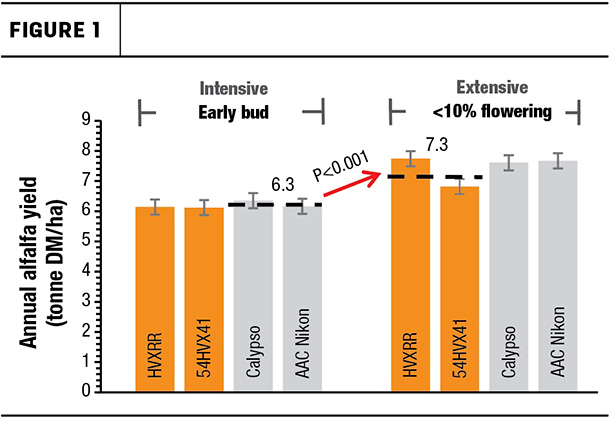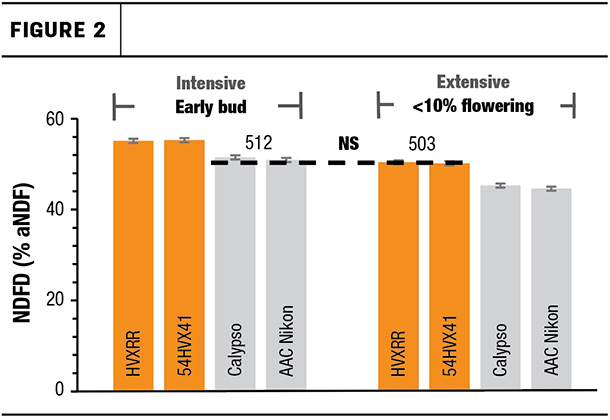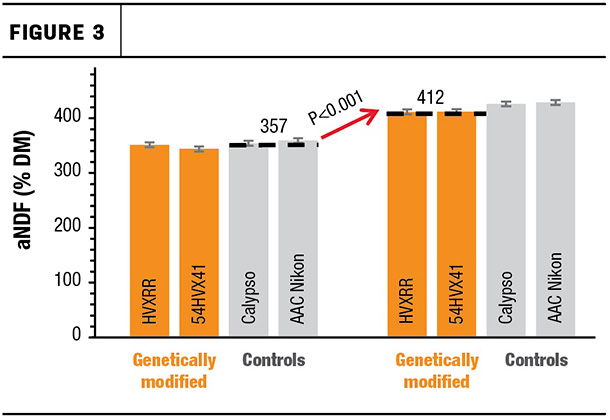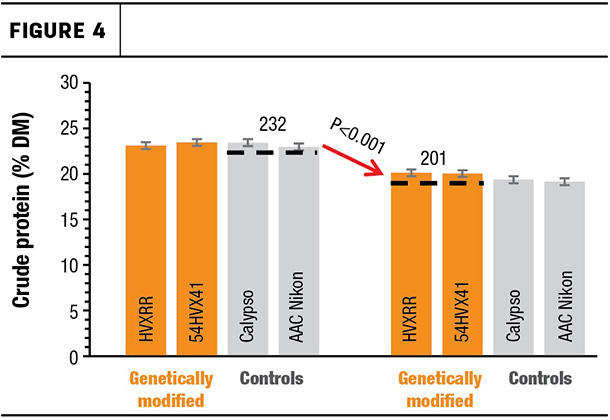Alfalfa is the most widely grown forage legume in Quebec, due in part to its high yield potential and high nutritive value. However, the quality of alfalfa decreases as the plant matures.As the fibre content increases, the fibre digestibility and crude protein (CP) content decreases. This decrease in fibre digestibility is mainly due to the increase in lignin concentration in the plant.
Lignin is a complex molecule found in cell walls. It gives stems the rigidity necessary for upwards growth. At the same time, it makes the cell walls much less digestible. Since the concentration of lignin is higher in the stems than in the leaves, the increase in stem-to-leaf ratio as the plant matures also negatively affects forage digestibility.
The industry is looking for ways to improve the digestibility of alfalfa at a given stage to increase its energy content or to stagger its harvesting period and thus increase its yield, without compromising its quality. According to meta-analysis, which combines the results of several studies to increase the robustness of the results, a 1-percentage-unit improvement in in vitro neutral detergent fibre digestibility (NDFD) in forage results in increases of 0.17 kilogram per day in dry matter intake (DMI) and 0.25 kilogram per day in milk production, corrected to 4% fat in cows fed this forage.
It is also known that forage yield and quality are influenced by cutting management, requiring a balance between yield and quality. An alfalfa crop that allows for a slight delay in cutting time without affecting forage quality too much would provide wiggle room when the weather is less favourable for harvest. Thus, improving alfalfa fibre digestibility is a factor that deserves special attention. Working on its improvement is necessary – and accessing data to compare different cultivars and make the right choices on-farm, under our climate conditions, is essential.
How to improve alfalfa digestibility?
It is possible to modify the composition of cell walls through genetics to increase the digestibility of forage. Alfalfa cultivars have been developed through conventional breeding (selection and crossing of the best individuals) to reduce their lignin concentration, increase their pectin concentration or improve the stem’s enzymatic degradability. Cultivars that have been genetically modified for reduced lignin content have also been developed to improve the nutritive value of alfalfa by altering two genes involved in lignin biosynthesis.
More digestible alfalfa cultivars and the impact on the cutting management of these cultivars have never been assessed under our conditions. Although the social acceptability of genetically modified alfalfa is beyond the scope of agronomic studies, it still needs to be documented in Quebec. Obtaining comparative data including genetically modified alfalfa cultivars under our bioclimatic conditions may help in this reflection.
A research project was conducted in Quebec to compare the yield and nutritional value of eight alfalfa cultivars: two genetically modified with reduced lignin content (HarvXtra type), four conventionally selected for increased digestibility, two with reduced lignin content (Hi-Gest type), one with high pectin content, one with improved enzymatic degradability of the stalk and two controls.
These cultivars were harvested at either the early bud stage (four cuts per year; intensive management) or at less than 10% flowering (three cuts per year; extensive management) for two or three years at three sites. Two of the sites were in Saint-Augustin-de-Desmaures, Quebec, and the third was in Sainte-Anne-de-Bellevue on the Island of Montreal. The objectives of this research were to compare the yield, nutritive value and persistence of a few potentially more digestible alfalfa cultivars to those of control cultivars, under intensive or extensive cutting management and under Quebec’s bioclimatic conditions.
Impact on yield, nutritive value and persistence
All cultivars survived the first winter conditions well. Results from the first year of production – the year after seeding – show that all cultivars had seasonal yields comparable to the controls, except for the cultivar selected for improved enzymatic stem degradability, which had a lower yield than the controls (-13%) under both cutting managements. The genetically modified cultivars had an NDFD of 4.7% units higher and a neutral detergent fibre (NDF) content of 1% unit lower than the controls. The conventionally selected cultivars did not show superior digestibility, as their NDFD values were similar to the controls.
The genetically modified cultivars also offered greater harvest flexibility. With one less cutting per year when harvested at the early flowering stage, genetically modified cultivars had a 1 tonne DM per hectare higher seasonal yield (Figure 1) and similar NDFD (Figure 2) compared to control cultivars harvested at the early bud stage.


However, harvesting the genetically modified cultivars at an earlier stage also resulted in lower alfalfa CP content (-3.1% units; Figure 4), as well as higher NDF (+5.6% units; Figure 3) and lignin (+0.16% unit) contents than control cultivars harvested at an earlier stage.


Genetically modified alfalfa cultivars with reduced lignin content can therefore be used to increase the digestibility of the forage ration and thus potentially improve the feed efficiency of cows. They can also be used to postpone harvesting by a few days to increase yield while maintaining the same NDF digestibility of the earlier-harvested control cultivars, but they will be lower in protein and higher in NDF.
A technoeconomic analysis to assess the impact of these more digestible alfalfa on the variation of the net profit of Quebec dairy companies was carried out. The agronomic and technoeconomic analyses of the use of genetically modified alfalfa could then provide information that could help in the reflection on the social acceptability of these alfalfa cultivars in Quebec.
The authors of this article would like to acknowledge the funding received for their cooperative research and development from the Natural Sciences and Engineering Research Council of Canada (NSERC) in association with the Quebec consortium for industrial bioprocess research and innovation (CRIBIQ) and Novalait.
To learn more about the results and applications of this research, contact Gaëtan Tremblay and Caroline Halde, professor of agroecology at Laval University.







